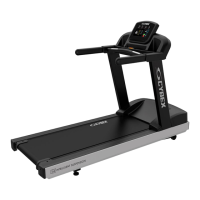Suggested exertion levels should be used as a guideline for setting up the Fit Test program. The goal is to elevate
the user's heart rate to a level that is between 60%-85% of their theoretical maximum heart rate. Within each
suggested range, these additional guidelines can be used:
Upper Half of RangeLower Half of Range
Lower AgeHigher Age
Higher Weight*Lower Weight
TallerShorter
* In cases of excessive weight, use lower half of range.
The computer will not accept:
• Heart rates less than 52 or greater than 200 beats per minute.
• Body weights less than 75 lbs. (34 kg) or greater than 400 lbs. (181 kg)
• Ages below 10 or over 99 years.
• Data input that exceeds human potential
It is important for you to take the Fit Test under similar circumstances each time. Your heart rate is dependent
on many factors, including:
• Amount of sleep the previous night (at least seven hours is recommended).
• Time of day.
• Time you last ate (two to four hours after the last meal is recommended).
• Time since you last drank a liquid containing caffeine or alcohol, or smoked a cigarette (at least four hours
is recommended).
• Time since you last exercised (at least six hours is recommended).
For the most accurate Fit Test results, you should perform the Fit Test on three consecutive days and average
the three scores.
Note: To receive a proper Fit Test score, the work done must be within a training heart rate zone that is
60% to 85% of the theoretical maximum heart rate (HRmax).
Relative Fitness Classification for Men
Estimated VO2 Max (ml/kg/min) Per Age Category
60+50-5940-4930-39
20-29Rating
43+47+51+52+55+Elite
41-4245-4649-5050-5153-54Excellent
39-4043-4446-4848-4950-52Very Good
35-3839-4242-4543-4745-49Above Average
31-3434-3837-4138-4240-44Average
29-3032-3334-3636-3738-39Below Average
26-2829-3132-3334-3535-37Low
<26<29<32<34<35Very Low
Relative Fitness Classification for Women
Estimated VO2 Max (ml/kg/min) Per Age Category
60+50-5940-4930-39
20-29Rating
Page 13 of 23

